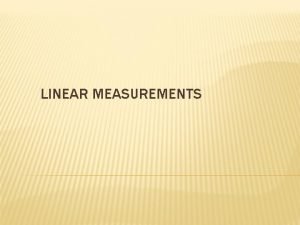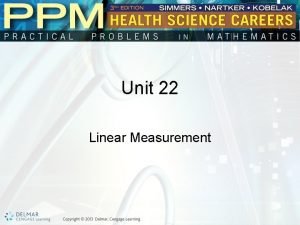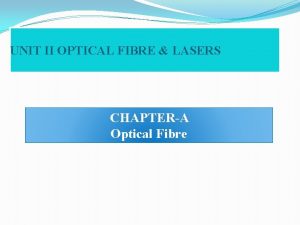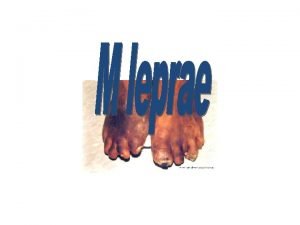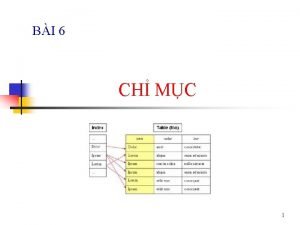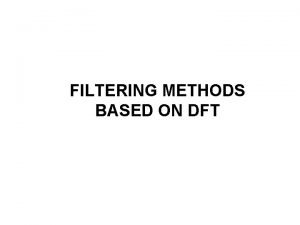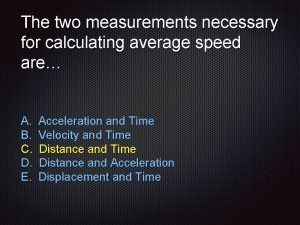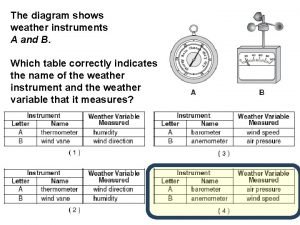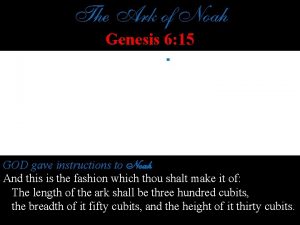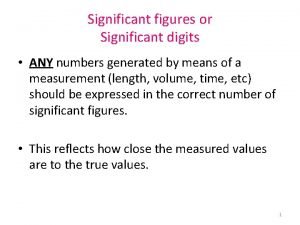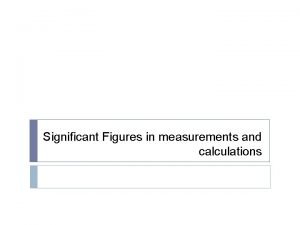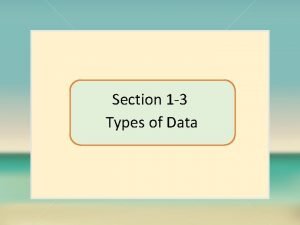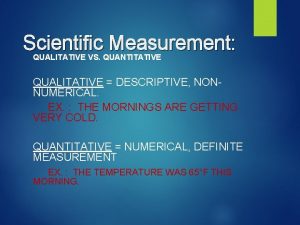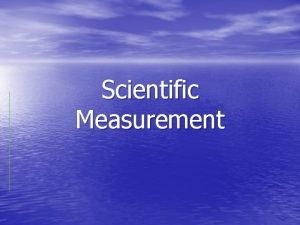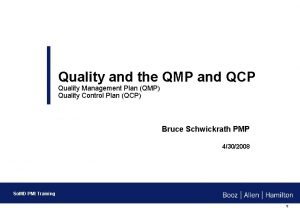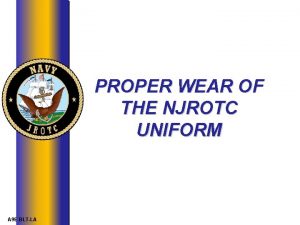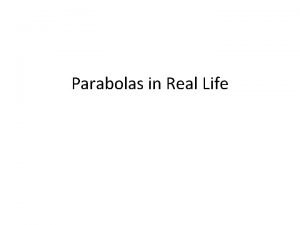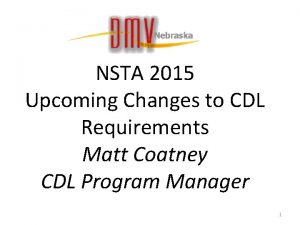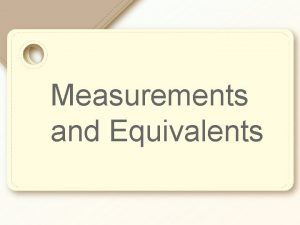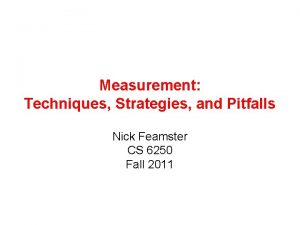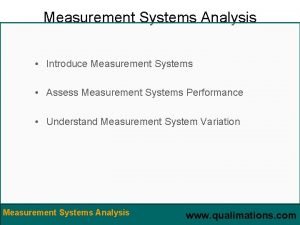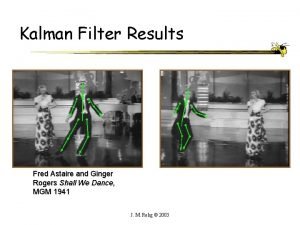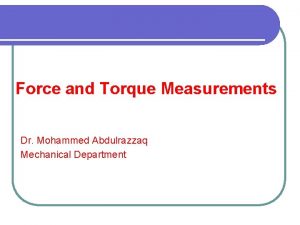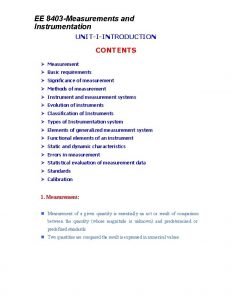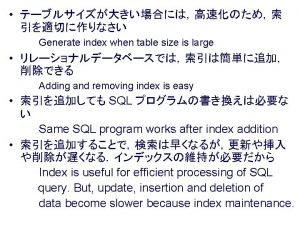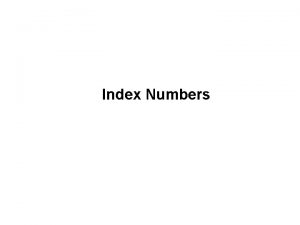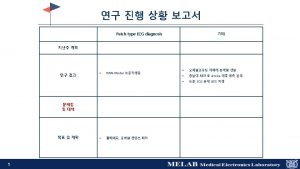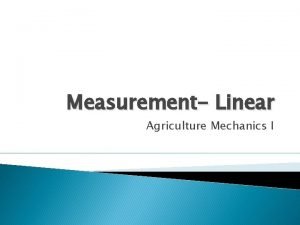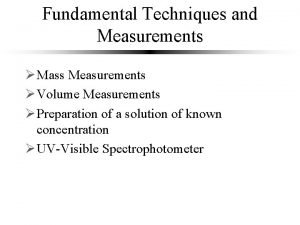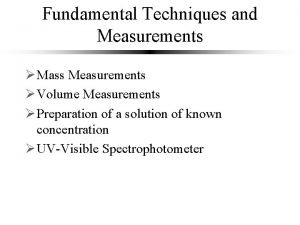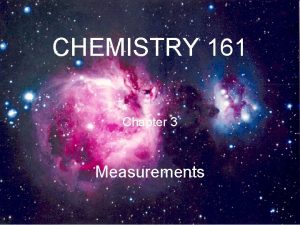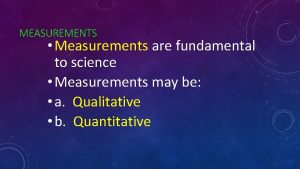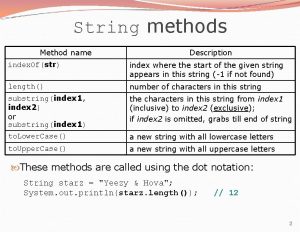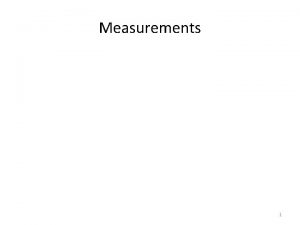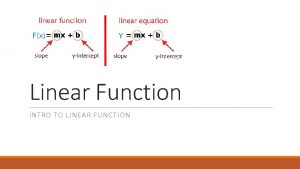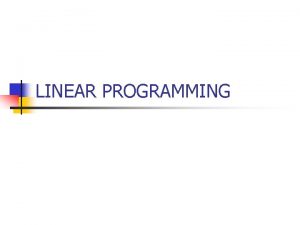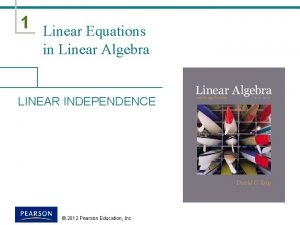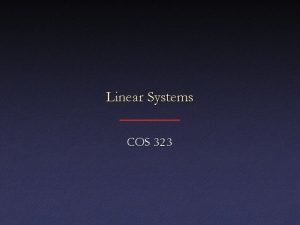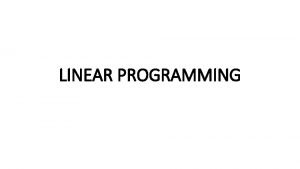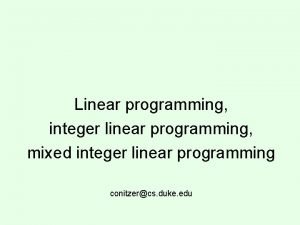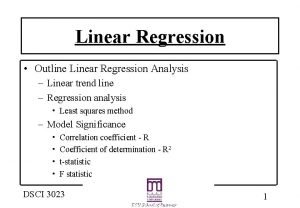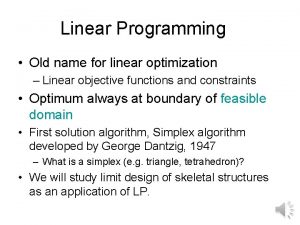LINEAR MEASUREMENTS INDEX v METHODS OF LINEAR MEASUREMNENT









































- Slides: 41

LINEAR MEASUREMENTS

INDEX v METHODS OF LINEAR MEASUREMNENT v APPROXIMATE METHODS v CHAIN SURVEYING v CHAIN v TAPES v RANGING RODS v METHODS USED IN CHAIN SURVEYING v PRINCIPLE OF CHAIN SURVEYING v SELECTION OF CHAIN SURVEYING v OFFSETS v ERRORS v TYPES OF ERRORS v SOURCE OF ERRORS

METHODS There are 3 methods of making linear measurements. 1 Direct Method. 2 Optical Method. 3 E. D. M Method.

APPROXIMATE METHODS Pacing. Passometer. Pedometer. Odometer. Speedometer. Measuring Wheel.

Speedometer pedometer odometer Measuring wheel passometer

INSTRUMENTS USED IN CHAIN SURVEYING 1) Chains 2) Tapes 3) Arrows 4) Ranging Rods and Offset Rod 5) Pegs 6) Plumb bob

TYPES OF CHAINS Metric chain Gunter’s chain or Surveyor’s chain Engineer’s chain Revenue chain Steel band or Band chain

CHAINS

TAKING MEASUREMENTS ON CHAIN Metric chains are made in lengths 20 m and 30 m. Tallies are fixed at every five meter length and brass rings are provided at every meter length except where tallies are attached.

TESTING AND ADJUSTMENT OF CHAIN 1) 2) 3) 4) 5) If chain is found to be too long Closing up the joints of the rings if found to be opened out. Reshaping the elongated rings. Replacing damaged rings. Removing one or more small rings. Adjusting the links at the end. 1) 2) 3) 4) 5) If chain is found to be too short Straightening the bent links. Opening the joints of the rings. Replacing one or more small circular rings by bigger ones. Inserting new rings where necessary. Adjusting the links at the end.

TYPES OF TAPES 1) 2) 3) 4) 5) Cloth or linen tape. Fibre tape. Metallic tape. Steel tape. Invar tape.

TAPES

ARROWS Arrows are made of tempered steel wire of diameter 4 mm. One end of the arrow is bent into a ring of diameter 50 mm and the other end is pointed. Its overall length is 400 mm. An arrow is inserted into the ground after every chain measured on the ground.

RANGING RODS AND OFFSET ROD Ranging rods are 2 to 3 m in length. Used for ranging some intermediate points on the survey line. Painted with alternate bands of black and white or red and white colours. With length of each equalising 20 cm.

RANGING RODS

PEGS Made of timber or steel. Used to mark the position of stations. Pegs are in length of 15 cm.

PLUMB-BOB Used to transfer points on ground. Used for fixing instrument exactly over the stations.

PRINCIPLE OF CHAIN SURVEYING Triangulation is the principle. In this area is divided into a number of triangles with the suitable sides. The plan of the area can be easily drawn. As a triangle is the only simple plane geometrical figure.

TERMS RELATED WITH CHAIN SURVEYING 1) Survey Stations: (a) Main stations (b) Subsidiary stations (c) tie stations 2) Main survey lines 3) Base line 4) Check line 5) Tie line


SELECTION OF SURVEY STATIONS 1) Survey lines should be minimum as far as possible and should be taken on fairly level ground. 2) should be intervisible. 3) Should form well conditioned triangles. 4) Should be located that tie lines, check lines, baseline etc. an be formed. 5) Should be selected within the boundary of the area to be surveyed.

OPERATIONS IN CHAIN SURVEYING Chaining Ranging Offsetting

CHAINING ON LEVEL GROUND Chaining on level ground It involves following operations 1) Fixing the stations. 2) Unfolding the chain. 3) Ranging. 4) Measuring the distance. 5) Folding the chain.

CHAINING ON SLOPING GROUND There are 2 methods: Direct Method: Also called as stepping. In this method, the distance is measured in small horizontal stretches. Say a 1, a 2 …an. with suitable length of chain or tape. finally the total horizontal distances are added to get the required distances

CHAIN SURVEYING (“STEPPING”) a w b x c y z


INDIRECT METHOD It involves calculation from directly measured lengths. Method 1: Horizontal distance of the segment is calculated by knowing sloping length of the segment and angle of inclination of that with horizontal. The angle of the sloping surface with horizontal can be known by instrument called Clinometer.

METHOD 2: If the elevation difference between 2 terminals points and the sloping distance between 2 terminal points is known the horizontal distance D can be calculated as D = (l² h²)

METHOD 3: Also called as hypotenusal allowance method Instead of putting the end arrow at actual end of chain, it is put at some advanced distance and that point is considered as the end of one chain length

RANGING 1) 2) There are 2 methods: Direct ranging Indirect ranging or reciprocal ranging.

DIRECT RANGING When intermediate ranging rods are fixed on a straight line by direct observation from end stations, the process is known as direct ranging. Direct ranging also can be done with a line ranger it consist of 2 right isosceles triangular prisms. Placed one above other.


INDIRECT OR RECIPROCAL RANGING When the end stations are not intervisible due to there being high ground between them, intermediate ranging rods are fixed on the line in an indirect way. The method is known as indirect ranging or reciprocal ranging.

Indirect Ranging

OFFSETTING 1) There are 2 types of offsets: Perpendicular offsets: the offsets which are taken perpendicular to the chain are termed as above. 2) Oblique offsets: Oblique distance is always greater than perpendicular distance. All the offsets which are not taken at right angle to chain line are known as above.

INSTRUMENTS FOR LAYING OFFSETS Optical square. Indian optical square. Open cross staff. Prism square.

ERRORS IN CHAINING 1) 2) There are 2 types Compensating errors Cumulating errors

SOURCES OF ERRORS IN CHAINING Instrumental Errors Natural errors Personal errors

ERRORS DUE TO INCORRECT CHAIN If chain is too long Measured distance will be less. Correction: positive If chain is too small Measured distance will be more. Correction: negative

TAPE CORRECTIONS Corrections for absolute length Corrections for temperature Corrections for pull Corrections for sag Corrections for slope

THANK YOU
 Speedometer
Speedometer Units of linear measurement
Units of linear measurement Direct wax pattern technique
Direct wax pattern technique Optical fibre
Optical fibre Dense secondary index
Dense secondary index Bacteriological index
Bacteriological index Pqli advantages and disadvantages
Pqli advantages and disadvantages Diff between step index and graded index fiber
Diff between step index and graded index fiber How to calculate simpsons diversity index
How to calculate simpsons diversity index Liquid limit of soil formula
Liquid limit of soil formula Clustered index và non clustered index
Clustered index và non clustered index Dft perform filtering operation in
Dft perform filtering operation in Direct methods for sparse linear systems
Direct methods for sparse linear systems Qm for windows linear programming
Qm for windows linear programming What two measurements are necessary for calculating speed?
What two measurements are necessary for calculating speed? Which diagram shows surface weather measurements
Which diagram shows surface weather measurements Genesis 6:15
Genesis 6:15 Significant figures definition
Significant figures definition When is 0 a significant figure
When is 0 a significant figure It consists of numbers representing counts or measurements.
It consists of numbers representing counts or measurements. Qualitative vs quantitative measurements
Qualitative vs quantitative measurements Measurements and their uncertainty
Measurements and their uncertainty Wrist rom goniometer
Wrist rom goniometer Qcpxxi5obqc -site:youtube.com
Qcpxxi5obqc -site:youtube.com Njrotc uniform measurements
Njrotc uniform measurements Wilkins score
Wilkins score Vibrating line and posterior palatal seal
Vibrating line and posterior palatal seal Real world parabola
Real world parabola Cdl parallel parking dimensions texas
Cdl parallel parking dimensions texas Measurements equivalents and adjustments
Measurements equivalents and adjustments Bgp measurements cs6250
Bgp measurements cs6250 Measurements system analysis
Measurements system analysis Attribute repeatability and reproducibility
Attribute repeatability and reproducibility Mathematical literacy grade 10 measurements
Mathematical literacy grade 10 measurements Triple jump measurement
Triple jump measurement Ginger rogers measurements
Ginger rogers measurements Chapter 2 measurements and calculations
Chapter 2 measurements and calculations Force and torque measurements
Force and torque measurements Ee8403 measurements and instrumentation
Ee8403 measurements and instrumentation Temperature is an anthropometric measurement
Temperature is an anthropometric measurement Chapter 37 vital signs and measurements
Chapter 37 vital signs and measurements Measurements in chemistry
Measurements in chemistry
